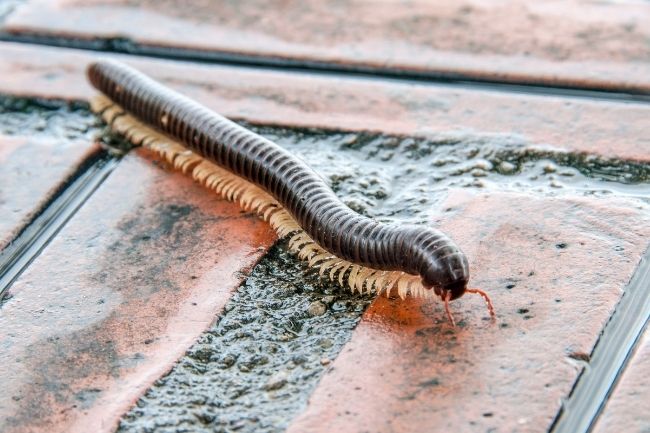Millipedes can range in size massively, depending on their species and age. Some are only a few millimetres long, while others are up to 33 cm in length.
Contents
Does size matter?

There are around 16,000 millipedes across the world, ranging from species a few millimetres long to the giant millipedes. Even across continents, their size can vary wildly depending on how they have adapted to their environment.
| Millipede Species | Maximum Recorded Length (inches) |
|---|---|
| Giant African Millipede | 15.4 |
| Amazonian Giant Centipede | 13.0 |
| Vietnamese Centipede | 11.8 |
| Tanzanian Blue-legged Centipede | 10.2 |
| Texas Red-headed Centipede | 9.6 |
Sex can also affect size, as in general, the females will be larger than the males. This is common within the animal kingdom, as females have the physically demanding task of producing and sometimes caring for the young.
Age is also an important consideration, as millipedes are not born the eventual size they become. Species are usually born with only a few body segments and no legs, gaining legs after each moult. However, this doesn’t necessarily mean that longer millipedes are older, as some species are naturally longer or shorter than others.
Millipedes of the world
| Region | Average Millipede Size (inches) |
|---|---|
| North America | 4.5 |
| South America | 6.8 |
| Europe | 3.2 |
| Africa | 7.5 |
| Asia | 5.1 |
| Australia | 9.0 |
UK
The UK is within the temperate zone and has around 62 species of millipede. There are no giant millipede species within the UK, aside from those kept as pets, and most species are only a few centimetres long.
Pill millipede
The pill millipede could easily be mistaken for a woodlouse, with its short, dumpy body. Individuals can be between 7 to 20 mm (0.27 to 0.78 in) in length, making it one of the smaller millipede species. Its shiny black colour with paler lines between the segments blends it in well with the leaf litter and soil it tends to spend its time in.
Garden symphylan
The garden symphylan is another tiny species, reaching only 6 mm (0.23 in) in length. This pale white species is easily confused for a centipede, as its body is much flatter than many millipede species. They like to live in compost heaps or leaf litter.
White-legged snake millipede
The white-legged snake millipede is a very common species in the UK, and one of the larger ones that can be found, coming in at around 2.5 cm (0.98 in). It is easily recognised by its dark body and pale white legs.
Also read: Millipede and its Legs (How Many, Why & Much More)
US
By comparison with the UK, the US has some fairly gigantic species, as well as more commonplace smaller species. The wide range of habitats across the area, allows for a wide range of different kinds of millipede, with 1,000 species in total.
Florida Scrub Millipede (Floridobolus penneri)
Reaching around 9 cm (3.54 in) in length, the Florida scrub millipede lives in a dry and sandy area of Florida, within burrows dug into the ground. Burrows can have several chambers, and the millipedes may use them temporarily, or on a longer-term basis.
Sierra luminous millipede
The Sierra luminous millipede has to be one of the most remarkable and interesting millipede species you can come across. It lives in the Sierra Nevada mountains and grows to around 4 cm (1.57 in) in length. What makes it exciting, however, is that it glows. Its use of bioluminescence is thought to be a way to scare off predators.
Greenhouse millipede
Growing up to 2.3 cm (0.90 in), the greenhouse millipede is so named because it can often be found happily living in people’s greenhouses. Brown in colour, with cream stripes, it is a very attractive species. One of the reasons it is so readily found in greenhouses is that is it not actually native to the US, originating in Japan.
Yellow-spotted millipede
The yellow-spotted millipede is an attractive arthropod, with bright yellow spots on its black body. It is generally thought this is a warning colouration to ward off predators, as it can emit a highly toxic chemical cocktail when frightened. It is found within damp forests along North America’s Pacific coast.
Flat-backed millipede
The flat-backed millipede is so named for its much flatter form than that of many other millipede species. They also have a series of orange dots down their body that make them a very distinctive species.
Giant Millipedes
Across the world, there are many species that fall into the ‘giant millipede’ category. These millipedes can often be favourites as pets, or for study due to their interesting lifestyles and appearance.
Africa Giant Millipede
The African Giant millipede is perhaps the most famous of the giant millipedes, being the largest species in the world. It grows to around 33 cm (12.99 in) in length and is found within subtropical forests in Africa, where they spend its time among the leaf litter.
American Giant Millipede
A black and brown millipede found along with eastern Northern America, the American giant millipede is around 10 cm (3.93 in) in length and eats primarily decaying wood and leaf litter.
Bumble bee Millipede
The bumble bee millipede is so named for its striking yellow and black stripes. Found around the Caribbean, it eats largely leaf litter and can grow to around 3 cm (1.18 in) in length.
How long is a piece of string?
When it comes to the question of how big millipedes are the real question should be ‘which one?’ There are many different species across the world, which grow into different lengths. Even within species, there can be a great deal of variation.
Going back into our distant past, millipedes were even more variable in their length, with the largest fossil found to date being 2.5 m (98.42 in) long. A small car’s worth of millipede.
The great thing is that no matter how long our millipedes become, they are still gentle giants, not interested in harming humans. Of course, some of them can give out some pretty noxious chemicals if upset, but left alone they are happily munching away at rotting wood and leaves, whatever size they might happen to be.
Also read: Here’s “What kills millipedes?” (List of Animals)

